Our first visit was 20 minute drive from Napflio to Koroniotis winery. Kiriakos Koroniotis returned from many years in the UK and Holland where he had worked as a chemical engineer and studied at agricultural university.
On a plot situated just inside the Nemea PDO area where his father had planted olive trees, he planted different grape varieties, settling on Malvasia in 1990. This variety originated in Greece, and is known as Monemvassia (it has an eponymous PDO of its own in the south of the Peloponnese). It is widely planted around the Mediterranean, and in Madeira (where it is made into Malmsey), and loves heat. In the vineyard we could see how much more foliage the vines had compared to the high altitude vineyard in Mantinia yesterday, and Kiriakos described his new approach to training with a thick canopy of leaves protecting grapes from sun.
In the winery, seated beside the chemical lab and served with lovely local breads and cheeses by Georgia, Kiriakos’s wife, we tasted a number of their wines, made from grapes he grows in his own vineyards and sourced from other areas of the Peloponnese.
The Malvasia had nice acidity, and a leafy spicy peachy flavour, while the 1300BC Assyrtiko was more aromatic with flinty notes. A Moschofilero rosé, Rōz Rêve, using grapes sourced from Mantinia was pale and delicate, while the Nemea PDO wine, 100% Agiorgitiko had deep colour with dark fruits and a hint of smoke on its powerful palate. The final wine was ‘Argus’, a Syrah, made from grapes grown at 1,000m near Patras (see later), this was a stunning wine, with beautiful flavours and great structure – a wine worth laying down for a few years, but drinking beautifully now.
This was a great tasting giving us insights into the variety of high quality wines being made in Greece, good to know that some of these are available through the Wine Society. Koroniotis means crown, and it is a very suitable name.
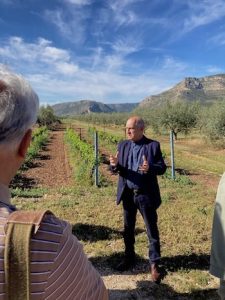
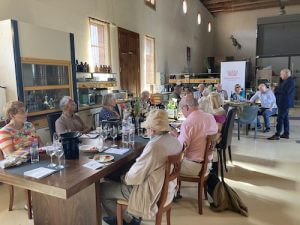
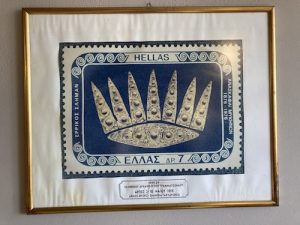
The contrast with the more rustic approach of Kalgoris yesterday was fascinating, and with some difficulty Tim shepherded us into the bus a couple of minutes after his target departure time, and we set off northwards.
An hour or so’s drive north then west, and up into the mountains of the Patras region, overlooking the gulf of Corinth, to the Tetramythos winery. Started in 1999 by a trio of wine enthusiasts, and very much a family business (the latest generation was a three year old!), this is one of Greece’s best know and most prestigious wineries. Named after the local wild pear trees (rather than a Greek myth), the winery has had its share of challenges – in 2007 it was burnt to the ground during the forest fires that swept through this part of the Peloponnese, destroying virtually all the current and historic stock, but was rebuilt sufficiently in 10 months to undertake the following harvest and get back on its feet.
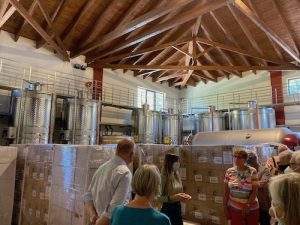
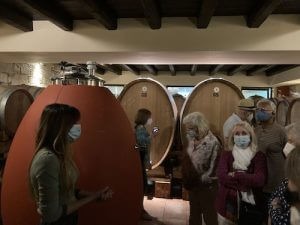
We learnt from Meli, the assistant winemaker, the great care with which these wines are made, with grapes sourced from both their own vineyards and contract growers with whom they have very long relationships. The terroir is incredible – vineyards are on steep slopes at altitudes between 650 and 1,050m, many north facing which helps to keep the vines cool, while the higher mountains inland protect them from hot southerly winds. Harvest starts in late August and can last into November for different varieties, all done by hand, so the winery is busy for several months. Fermentations are with natural yeasts, which and Meli showed us the wooden vessels, barriques, amphorae and concrete and clay eggs in which wines are fermented and matured. She also described the Retsina wine they make, a truly terroir-driven wine, using pine resin from the local area, and as we were to taste, totally different to the retsinas some of us had experienced in previous visits to Greece.
A tasting preceded lunch, the Roditis was a lovely delicate wine with blossom and green apple flavours and a creamy texture, while the Malagousia was more herbal and zesty. The Retsina, made from Roditis with just 1kg of dried resin fermented with every 1,000l of wine, had a hint of pine which added to the complexity, and was the favourite of the tasting for several people.
Our reds were a Black of Kalavryta, a nearly extinct black variety that is making a comeback – a lovely light wine with fresh fruit flavours and very pleasant tannins – a foody wine that was very sippable. The 2015 Cabernet Sauvignon was fascinating – very evolved with dried fruit, forest floor flavours and elegant tannins.
We saved the final wine to pudding (sour cherry compote), and it was fabulous – Mavrodaphne is the key variety of the Patras region, used to make traditional fortified sweet wines under a number of PDOs. This wine was not fortified but had reached 16.5% alcohol with 70g of residual sugar still remaning (and took 38 months to ferment, with 5 years in oak following) – a lovely medium sweet wine, perfectly balanced with a mix of christmas cake and blackcurrant jam flavours. Very unusual, and very enjoyable.
We thanked Meli and the chief oenologist Panagoiotis (one of the three partners) on the terrace overlooking the fabulous view, and then clambered into the bus for the journey back. Another fantastic day.
